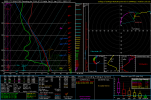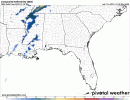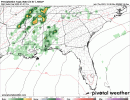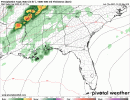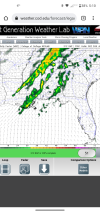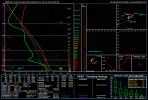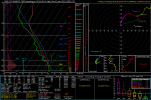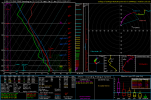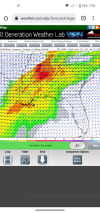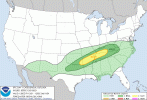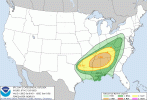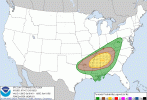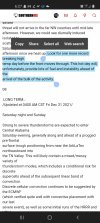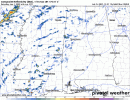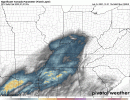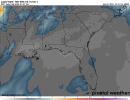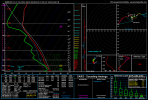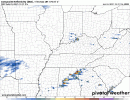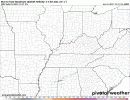.SHORT TERM...
/Updated at 0400 AM CST Fri Dec 31 2021/
Today through Saturday.
This AM, satellite and observations indicate lots of low
stratus and
dense
fog across Central Alabama. Visibilities are varying widely as
they tank, go up temporarily, and then go back down again. A dense
fog advisory remains in effect until 9 AM for the entire forecast
area. Otherwise, we have some light rain showers/drizzle across
portions of the area as well at this time. Temperatures this AM are
cooler than they have been the last few days for many with a surface
boundary stretched across the
SRN fringes of the
CWA. This boundary
is expected to make its way
NWD today as a warm
front. This will
allow for those mild overnight temperatures and higher
dew points to
rebound tonight as it does so.
Fog will be possible again tonight,
but it should not be as dense.
Our main frontal system is not expected to be arriving in the NW
counties until Saturday evening. Pre-frontal bands and the severe
threat will not arrive in the far NW counties until mid-late
afternoon. However, we could see diurnally induced
isolated to
scattered convection in the area ahead of that time Saturday
afternoon once we heat up. Look for one more record breaking high
temp day before the
front moves through. This hot day will,
unfortunately, provide lots of fuel and
instability ahead of the
arrival of the bulk of the activity.
08
.LONG TERM...
/Updated at 0400 AM CST Fri Dec 31 2021/
Saturday night and Sunday.
Strong to severe thunderstorms are expected to enter Central Alabama
Saturday evening, generally along and ahead of a
progged pre-frontal
surface
trough positioning from near the ArkLaTex northeastward into
the TN Valley. This will
likely contain a mixed/messy variety of
thunderstorm modes, which includes a conditional risk for discrete
supercells ahead of the subsequent linear band of
convection.
Discrete cellular
convection continues to be suggested by the
ECMWF
(which verified quite well with convective placement with our last
severe event), as well as some initial runs of the HRRR and HRW
FV3. Pressure falls associated with the pre-frontal surface
trough should keep surface winds backed to a south-southwesterly
direction during this time. These winds will coincide with a 50-60
kt southwesterly low-level
jet, and from there, gain further
momentum with
height, though not changing direction much. Thus,
deep-layer
flow still seems to remain mostly parallel surface
features; this has always been a source of uncertainty for
anticipated severe risks, but a more supportive factor for locally
heavy
rainfall. Nonetheless, my overall expectation is for 0-1 km
wind profiles to support 200-300
m2/s2 SRH along with the
expected 60+
kts eff. bulk
shear. These kinematic fields support
all modes of severe weather given any robust
thunderstorm
updrafts, either discrete or line-embedded supercells. Expected
thermodynamics include 500-1,000
J/kg MLCAPE, particularly after
sunset when guidance suggests
height falls occur overtop the
unusually warm, moist
warm sector.
Height falls/cooling aloft will
help improve mid-level lapse rates, which most guidance suggests
for the majority of the afternoon are not that good. This seems to
be the main reason more muted
instability values appear in
guidance despite what could be another record-breaking warm
afternoon Saturday.
For now it appears the best chance for severe convective weather
will be along and north of I-20 from Saturday afternoon through the
early morning hours on Sunday. By later in that period, pressure
falls begin to subside with the northeastward departure of the
surface low. This will allow
veering of 0-3 km
flow to occur which
will reduce overall severe weather threats, especially the
tornado
threat. This should occur as the convective line nears the I-85
corridor. All severe weather should continue to diminish from there
as 850
mb flow becomes westerly behind the exiting low-level
jet and
the surging polar
air mass infiltrates Central Alabama from the
northwest. By then any lingering thunderstorms should have exited
the area anyway.
Guidance continues to suggest a lagging
vort max swinging through
the Deep South at the base of the parent positively tilted upper-
level
trough. This has continued to leave the door open for
PoPs
throughout Sunday as residual
moisture below 700
mb interacts with
lift aloft (
PVA). By late Sunday afternoon/evening, most
lingering
moisture should now reside below 850
mb. Throughout this
period lies an overlap of critical thickness values supportive of
a glancing transition to light snow/flurries across the northern
part of the forecast area. This is also suggested in various
forecast soundings. Despite this, no accumulation is expected;
QPF
is zero. Sunday night will be a huge transition in temperatures
considering the extended period of unusual December warmth.

